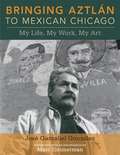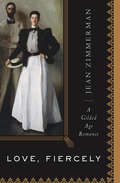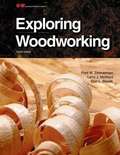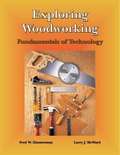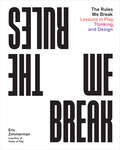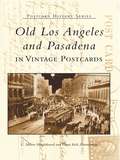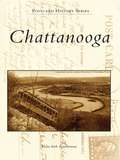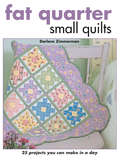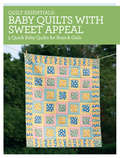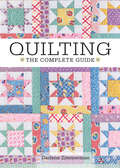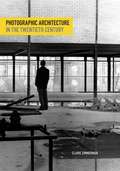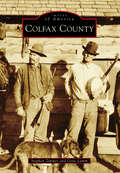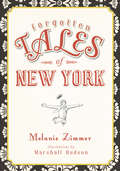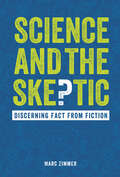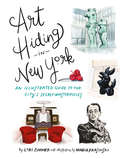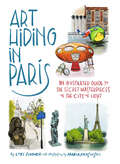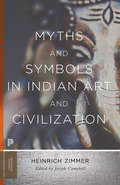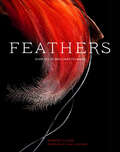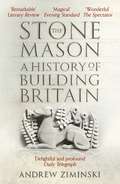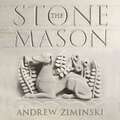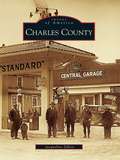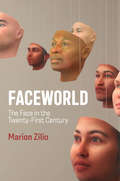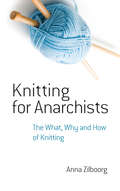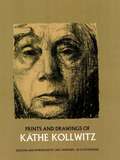- Table View
- List View
Digital Infrastructures: Enabling Civil and Environmental Systems through Information Technology (Networked Cities Series)
by Rae Zimmerman Thomas HoranAn invisible network of digital technology systems underlies the highly visible networks of roads, waterways, satellites, and power-lines. Increasingly, these systems are becoming the "infrastructure's infrastructure," providing a crucial array of data on network demand, performance, reliability, and security. Digital Infrastructures presents an interdisciplinary analysis of the technological systems that envelop these networks. The book balances analyses of specific civil and environmental infrastructures with broader policy and management issues, including the challenges of using IT to manage these critical systems under crises conditions.
Bringing Aztlan to Mexican Chicago: My Life, My Work, My Art
by Marc Zimmerman Jose Gamaliel GonzalezBringing Aztlán to Mexican Chicago is the autobiography of Jóse Gamaliel González, an impassioned artist willing to risk all for the empowerment of his marginalized and oppressed community. Through recollections emerging in a series of interviews conducted over a period of six years by his friend Marc Zimmerman, González looks back on his life and his role in developing Mexican, Chicano, and Latino art as a fundamental dimension of the city he came to call home. Born near Monterey, Mexico, and raised in a steel mill town in northwest Indiana, González studied art at the School of the Art Institute of Chicago and the University of Notre Dame. Settling in Chicago, he founded two major art groups: El Movimiento Artístico Chicano (MARCH) in the 1970s and Mi Raza Arts Consortium (MIRA) in the 1980s. With numerous illustrations, this book portrays González's all-but-forgotten community advocacy, his commitments and conflicts, and his long struggle to bring quality arts programming to the city. By turns dramatic and humorous, his narrative also covers his bouts of illness, his relationships with other artists and arts promoters, and his place within city and barrio politics.
Love, Fiercely: A Gilded Age Romance
by Jean ZimmermanThe true story of the New York society couple portrayed in the John Singer Sargent painting—an architect and an heiress who became passionate reformers. Contemporaries of the Astors and Vanderbilts, they grew up together along the shores of bucolic Staten Island, linked by privilege—her grandparents built the world&’s fastest clipper ship, while his family owned most of Murray Hill. Theirs was a world filled with mansions, balls, summer homes, and extended European vacations. This fascinating biography re-creates the glittering world of Edith Minturn and Isaac Newton Phelps Stokes—and reveals how their love for each other was matched by their dedication to others. Newton became a passionate preserver of New York history and published the finest collection of Manhattan maps and views in a six-volume series. Edith became the face of the age when Daniel Chester French sculpted her for Chicago&’s Columbian Exposition, a colossus intended to match the Statue of Liberty&’s grandeur. But beyond their life of prominence and prestige, Edith and Newton battled together on behalf of New York&’s poor and powerless—and through it all, sustained a strong-rooted marriage. From the splendid cottages of the Berkshires to the salons of 1890s Paris, Love, Fiercely tells the real-life story behind Mr. and Mrs. I .N. Phelps Stokes—one of the Gilded Age&’s most famous works of art. &“With an impressive amount of research behind every page, Zimmerman manages to capture the sweeping drama of the turn of the century as well as the compelling story of a couple who knew how to love, fiercely. Her superb pacing and gripping narrative will appeal to all who enjoy history, biography, and real-life romance.&” —Library Journal
Exploring Woodworking (Eighth Edition)
by Fred W. Zimmerman Larry J. Mcward Don L. BlazekExploring Woodworking provides the essential knowledge that beginning students require. It introduces different woods and their characteristics in addition to basic techniques using hand and power tools. Information regarding woodworking operations, such as drilling and sawing, is presented in individual chapters to ensure in-depth coverage. Product designs for woodworking projects are included. An entrepreneurship chapter explains how to organize and operate an in-school manufacturing business, giving students hands-on experience with financing, marketing, and construction. The text also introduces students to the industrial woodworking environment to provide insight into the potential workplace.
Exploring Woodworking
by Fred W. Zimmerman Larry J. McWardExploring Woodworking provides a thorough foundation for a beginning woodworking course. This clearly written and highly illustrated text introduces students to woods and their characteristics, as well as basic woodworking techniques using both hand and power tools. Plans for a number of woodworking products are included.
The Rules We Break: Lessons in Play, Thinking, and Design
by Eric ZimmermanWhether you're a game player, a designer of any kind, or someone who wants to know more about design, The Rules We Break will open your mind to creative and thought-provoking approaches to design. Play through more than 20 hands-on, real-world games and exercises to explore how people think, how games and systems work, and how to move through a creative process. Everyone can learn from game design: interaction designers and software developers, graphic designers and urban planners, kids in after-school programs and university students studying design. This collection of interactive games and exercises is designed to help you consider new ways of approaching productive collaboration, creative problem solving, analysis of systems, and how to communicate ideas, providing skills you can use in any discipline or situation. These real-world exercises are designed to be played on tabletops, as playground-style physical games, and via social interactions with others in person or online. A wide range of entertaining, thought-provoking games, exercises, and short essays grow in complexity over the course of the book, from 20 minutes of play to design projects that last for days or weeks. Award-winning game designer Eric Zimmerman invites you to play your way through it all, learning about play, systems, and design along the way.
Old Los Angeles and Pasadena in Vintage Postcards
by Elena Irish Zimmerman C. Milton HinshilwoodCovering the history and geography of Los Angeles and Pasadena between 1900 and 1950, the collection of over 200 vintage postcards compiled in this new volume offers a unique glimpse into turn-of-the-century southern California. As communication by postcards became popular in the late 19th century, those who received them were offered a rare view of the "right here, right now" aspect that only postcard photography could offer. From the earliest images of the Angels' Flight in Los Angeles, to the Tournament of Roses parades gliding down Colorado Street, the authors celebrate the history of these two beautiful cities through the personal medium of vintage postcards.
Chattanooga
by Elena Irish ZimmermanLocated near the Georgia and Alabama state lines on the sharp Moccasin Bend of the Tennessee River, Chattanooga is steeped in history. The town has served as an important junction for river traffic, a stronghold of Native American culture, the site of several noteworthy Civil War battles, and a popular destination for tourists from all over the country.
Fat Quarter Small Quilts: 25 Projects You Can Make in a Day
by Darlene ZimmermanQuarter-yard ("fat quarter") quilts are the hottest thing in quilting today. They're small, stylish and easy to complete in a night or weekend. This new guide to using these popular cuts of fabric in a broad array of styles and designs, is sure to be a hit! The 25 fat quarter small quilts featured in the book feature themes such as "Classic," "Just for Fun," "Country Charm," and "Vintage," and can be used as wall hangings, tablemats, doll quilts, gifts and more. This book features a how-to section with colorful graphics, a tool tutorial, and a special section showing color and fabric variations of the same quilt, giving quilters inspiration to create their own designs.
Quilt Essentials - Baby Quilts with Sweet Appeal: 5 Quick Baby Quilts for Boys & Girls (Quilt Essentials)
by Darlene ZimmermanWrap your bundle of joy in a keepsake quilt! Includes 5 quilts that are suitable for both boys and girls. Cute and simple, these projects are easy enough for beginning quilters. Clear diagrams and detailed instructions make sewing a snap!
Quilting - The Complete Guide
by Darlene ZimmermanQuilting - The Complete Guide lives up to its name! It covers all of the essential knowledge you need to complete any quilting project: the tools, formulas, methods, finishing techniques, and quilt care you need to know. It's the perfect companion for all quilting projects.
Photographic Architecture in the Twentieth Century
by Claire ZimmermanOne hundred years ago, architects found in the medium of photography--so good at representing a building's lines and planes--a necessary way to promote their practices. It soon became apparent, however, that photography did more than reproduce what it depicted. It altered both subject and reception, as architecture in the twentieth century was enlisted as a form of mass communication. Claire Zimmerman reveals how photography profoundly influenced architectural design in the past century, playing an instrumental role in the evolution of modern architecture. Her "picture anthropology" demonstrates how buildings changed irrevocably and substantially through their interaction with photography, beginning with the emergence of mass-printed photographically illustrated texts in Germany before World War II and concluding with the postwar age of commercial advertising. In taking up "photographic architecture," Zimmerman considers two interconnected topics: first, architectural photography and its circulation; and second, the impact of photography on architectural design. She describes how architectural photographic protocols developed in Germany in the early twentieth century, expanded significantly in the wartime and postwar diaspora, and accelerated dramatically with the advent of postmodernism. In modern architecture, she argues, how buildings looked and how photographs made them look overlapped in consequential ways. In architecture and photography, the modernist concepts that were visible to the largest number over the widest terrain with the greatest clarity carried the day. This richly illustrated work shows, for the first time, how new ideas and new buildings arose from the interplay of photography and architecture--transforming how we see the world and how we act on it.
Colfax County
by Stephen Zimmer Gene LammIn 1841, Carlos Beaubien and Guadalupe Miranda received a grant of land from the governor of New Mexico in the northeastern part of the Mexican province. Frontier conditions prevented colonization of the grant until 1848, when Beaubien's son-in-law Lucien Maxwell led settlers from Taos to the Rayado River where it crossed the Santa Fe Trail. Maxwell's friend Kit Carson joined him the following year, and their ranch prospered in spite of frequent attacks by Jicarilla Apaches. Later, Maxwell moved north to the Cimarron River. Gold was discovered on the western part of the grant in 1866, and miners rushed to the diggings, establishing the town of Elizabethtown. It became the first seat of Colfax County in 1869. Maxwell sold the grant to foreign investors who organized the Maxwell Land Grant and Railway Company in 1870 and founded the town of Cimarron. The Santa Fe Railroad entered the county in 1879, which precipitated the creation of the towns of Raton and Springer and also fostered large-scale ranching, mining, and lumbering.
Forgotten Tales of New York (Forgotten Tales Ser.)
by Melanie ZimmerLearn the Empire State&’s little known history—from bone-stealing dogs to the world&’s largest puzzle—by the author of Curiosities of the Finger Lakes. Few New Yorkers remember the night when firemen, in tuxedos and top hats, were dragged from a ball to extinguish a Waterloo blaze, or the typographical error that reported Theodore Roosevelt taking a &“bath&” instead of his presidential &“oath.&” Still fewer remember Cephas Bennett, a missionary from Utica and printer of the first Burmese Bible, or H. L. Mencken&’s humorous article on the history of the bathtub, still quoted today as factual although entirely invented. Seasoned storyteller Melanie Zimmer seamlessly weaves together these hard-to-believe, yet entirely true, tales. From the monster of Seneca Lake to the man who inspired the American icon Uncle Sam, discover the lost secrets of the Empire State. Includes photos!
Science and the Skeptic: Discerning Fact from Fiction
by Marc ZimmerFake news, pseudoscience, and quackery have become scourges, spreading through society from social media all the way to Congress. The line between entertainment and reality, between fact and fiction, has become blurred. Some of the most crucial issues of our time—climate change, vaccines, and genetically modified organisms—have become prime targets for nefarious disinformation campaigns. Far too many people have become distrustful of real science. Even those who still trust science no longer know what to believe or how to identify the truth. Not only does this result in the devaluation and distrust of real science, but it is also dangerous: people acting based on false information can hurt themselves or those around them. We must equip ourselves with the knowledge and skills to fight back against all this disinformation. InScience and the Skeptic: Discerning Fact from Fiction, you will learn how science is done, from the basic scientific method to the vetting process that scientific papers must go through to become published; how and why some people intentionally or unintentionally spread misinformation; and the dangers in believing and spreading false information. You'll also find twenty easy-to-follow rules for distinguishing fake science from the real deal. Armed with this book, empower yourself with knowledge, learning what information to trust and what to dismiss as deceit. "We're not just fighting an epidemic; we're fighting an infodemic. . . . This is a time for facts, not fear. This is a time for rationality, not rumors. This is a time for solidarity, not stigma."—Tedros Adhanom Ghebreyesus, director-general of the WHO "Our deepest beliefs should help navigate reality, not determine it."—Michael Gersen, The Washington Post "Journalism is very much about trying to simplify and distribute information about what's new and where advances have been made. That's incompatible with the scientific process, which can take a long time to build a body of evidence."—Kelly McBride, Poynter Institute
Art Hiding in New York: An Illustrated Guide to the City's Secret Masterpieces
by Lori ZimmerUncover the artistic masterworks hidden across New York City in this charmingly illustrated exploration of one of the world's greatest creative treasure troves.There's so much to love about New York, and so much to see. The city is full of art, and architecture, and history -- and not just in museums. Hidden in plain sight, in office building lobbies, on street corners, and tucked into Soho lofts, there's a treasure trove of art waiting to be discovered, and you don't need an art history degree to fall in love with it. Art Hiding in New York is a beautiful, giftable book that explores all of these locations, traversing Manhattan to brings 100 treasures to art lovers and intrepid New York adventurers. Curator and urban explorer Lori Zimmer brings readers along to sites covering the biggest names of the 20th century -- like Jean-Michel Basquiat's studio, iconic Keith Haring murals, the controversial site of Richard Serra's Tilted Arc, Roy Lichtenstein's subway station commission, and many more. Each entry is accompanied by a beautiful watercolor depiction of the work by artist Maria Krasinski, as well as location information for those itching to see for themselves. With stunning details, perfect for displaying on any art lover's shelf, and curated itineraries for planning your next urban exploration, this inspirational book is a must-read for those who love art, New York, and, of course, both.
Art Hiding in Paris: An Illustrated Guide to the Secret Masterpieces of the City of Light
by Lori ZimmerExplore masterpieces hidden in plain sight, historic artist enclaves, and iconic works of public art in this charmingly illustrated exploration of Paris, from the authors of Art Hiding In New York.Paris is the city of light, the city of love, and the city of more art than you could possibly explore in a lifetime—and not just in museums. Tucked away in tree-lined parks, preserved in world class restaurants, emblazoned on Metro station walls, and hidden in the most unexpected places are masterpieces worthy of the Louvre, if you know where to look! In this whimsically illustrated celebration of Parisian art and artists, author and curator Lori Zimmer highlights more than 100 treasures. From the gorgeous remnants of the Art Nouveau era to the homes of some of the world's most influential artists—including Vincent Van Gogh, Pablo Picasso, and more—to an introduction to the modern masters of urban art, there are endless riches to be explored. Discover art that was hidden for decades inside cafes, shops and even a Belle Époque brothel! Paris will surprise you.Illustrated by artist Maria Krasinski, this book provides curated itineraries for dreaming up your next urban exploration, and is perfect for displaying on any art lover's shelf.
Myths and Symbols in Indian Art and Civilization (Princeton Classics #111)
by Heinrich Robert ZimmerA landmark work that demystifies the rich tradition of Indian art, Myths and Symbols in Indian Art and Civilization analyzes key motifs found in legend, myth, and folklore taken directly from the Sanskrit. It provides a comprehensive introduction to visual thinking and picture reading in Indian art and thought. Ultimately, the book shows that profound Hindu and Buddhist intuitions on the riddles of life and death are universally recognizable.
Feathers: Displays of Brilliant Plumage
by Carl Zimmer Robert ClarkExquisite images from award-winning National Geographic photographer Robert Clark offer a captivating perspective on the vast beauty and myriad functions of a seemingly simple thing: the bird feather. Each detailed close-up is paired with informative text about the utility and evolution of the feather it depicts, making this handsome marriage of art and science the ideal book for bird lovers, natural history buffs, and photography enthusiasts.
The Stonemason: A History of Building Britain
by Andrew ZiminskiA stonemason's story of the building of Britain: part archaeological history, part deeply personal insight into an ancient craft. In his thirty-year career, stonemason Andrew Ziminski has worked on many of our greatest monuments. From Neolithic monoliths to Roman baths and temples, from the tower of Salisbury Cathedral to the engine houses, mills and aqueducts of the Industrial Revolution and beyond, The Stonemason is his very personal history of how Britain was built - from the inside out. Stone by different stone, culture by different culture, Andrew Ziminski (with his faithful whippet in tow) takes us on an unforgettable journey by river, road and sea through our countryside showing how the making of Britain's buildings offers an unexpected and new version of our island story.'My school history lessons were focused around flat pages of facts, events and royal personalities, but for me it was the material aspects of the past, the tangible remnants left behind that were thrilling, and that it was these buildings and places, and learning how they worked, that really brought the past alive.'
The Stonemason: A History of Building Britain
by Andrew ZiminskiPart-hands-on archaeological history of Britain, part-deeply personal insight into this ancient craft by a stonemason who has worked on Britain's greatest monuments, from Salisbury Cathedral to St Paul's.Following a tradition that dates back hundreds of years, stonemason Andrew Ziminski has worked on many of Britain's greatest monuments, from the Roman ruins of Bath to Salisbury Cathedral's spire to St Paul's, and his three decades of work give a unique perspective on the warp and weft of English history, nature and geology.From the first stone megaliths put up by Neolithic farmers, through the Roman baths and temples, the Anglo-Saxon and Norman churches, to the engine houses, mills and aqueducts of the Industrial revolution, in The Stonemason Andrew journeys around by way of river, road and sea to explore the routes that ideas, migrants and building materials took to create some of Britain's most iconic historic buildings and ancient monuments. (P)2019 Hodder & Stoughton Limited
Charles County
by Jacqueline ZillioxFaithful subjects of the English crown, Jesuits, and entrepreneurs first settled in Charles County in the early 1630s. The area quickly sprouted into Colonial-styled plantation life of distinct Southern charm. The currency of the day was tobacco, even for payment of taxes and doctor bills. Through the War of 1812 and the Civil War, the mainly agricultural economy of the county was devastated. But as time passed, plantations became farmsteads, Native American trails became roadways, and the railroad created new town centers, such as Waldorf and La Plata. In the earlier years, the county's self-sufficiency was strongly displayed when the public school system and fire departments were started through private donations. For most of its life, Charles County's only employer not associated with agriculture was the Indian Head Naval Proving Ground, now known as the Indian Head Division, Naval Surface Warfare Center. It is still ranked as the county's number one employer. Tobacco still reigned as the cash crop of choice until 2000.
Faceworld
by Marion ZilioWe have long accepted the face as the most natural and self-evident thing, believing that in it we could read, as if on a screen, our emotions and our doubts, our anger and joy. We have decorated them, made them up, designed them, as if the face were the true calling card of our personality, the public manifestation of our inner being. Nothing could be further from the truth. Rather than a window opening onto our inner nature, the face has always been a technical artefact—a construction that owes as much to artificiality as to our genetic inheritance. From the origins of humanity to the triumph of the selfie, Marion Zilio charts the history of the technical, economic, political, legal, and artistic fabrication of the face. Her account of this history culminates in a radical new interrogation of what is too often denounced as our contemporary narcissism. In fact, argues Zilio, the “narcissism” of the selfie may well reconnect us to the deepest sources of the human manufacture of faces—a reconnection that would also be a chance for us to come to terms with the non-human part of ourselves. This highly original reflection on the fabrication of the face will be of great value to students and scholars of media and culture and to anyone interested in the pervasiveness of the face in our contemporary age of the selfie.
Knitting for Anarchists: The What, Why and How of Knitting (Dover Knitting, Crochet, Tatting, Lace)
by Anna ZilboorgEvery knitter takes a different approach, and this revolutionary guide fosters experimentation and self-expression. Author Anna Zilboorg defies the notion of a one-size-fits-all teaching method, assuring readers that the techniques most comfortable and intuitive for individual knitters are always correct. Her explorations of the construction of knitted fabrics are founded upon the understanding that there are many different ways to produce the same satisfying result.Offering advice rather than rules, Knitting for Anarchists promises to broaden the horizons of active knitters and to encourage beginners. Patterns for sweaters, pullovers, and cardigans include helpful photos, charts, and directions that serve not only as guidelines but also as springboards for unlimited variations.
Prints and Drawings of Käthe Kollwitz
by Carl Zigrosser Käthe Kollwitz"The Weavers," a landmark of class-conscious art, which depicts, in a series of prints, the plight of the worker and his age-long struggle to better his lot. "Death as a Friend," showing a man greeting his death as an old friend, with a hysterical mixture of joy and terror. "The People," in which a mother shields her offspring from phantoms of hate, poverty, and ignorance -- and symbolizes woman as creator, begetter of the human race, link between past and future.These works represent the recurrent themes which most characterize the work of Käthe Kollwitz: social consciousness and a sense of the suffering of mankind, an urge to voice the basic maternal attitude, and a preoccupation with death. She has been called a propagandist, a crusader, yet her art is essentially apolitical. Her concern was not with partisan causes, but rather with universal rights.Fundamentally a dramatic artist, Käthe Kollwitz (1867-1945) brought to each of her works an uncanny ability to evoke human emotions through subtle gestures and facial expressions. The reactions of her characters were psychologically true primarily because she tested them on herself.The present collection contains 83 of Mrs. Kollwitz's finest works, including the last great print cycles: "The Weavers" of 1898; "The Peasant War" of 1908; "War" of 1925; and "Death" of 1935. These selections provide a full panorama of Mrs. Kollwitz's development as a master of the graphic techniques of etching, woodcutting and lithography. Over 69 of the illustrations have been rephotographed from the original works specially for this edition, and new techniques in photolithography and a larger format have resulted in reproductions that are as close as possible to the prints and drawings themselves.

